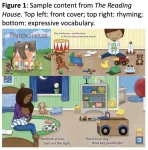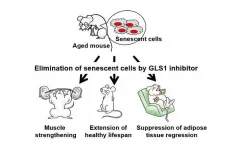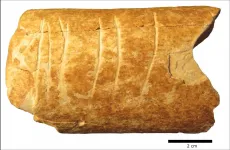(Press-News.org) A study published in the journal Pediatrics expands validation evidence for a new screening tool that directly engages preschool-age children during clinic visits to assess their early literacy skills. The tool, which is the first of its kind, has the potential to identify reading difficulties as early as possible, target interventions and empower families to help their child at home, according to researchers at Cincinnati Children's Hospital Medical Center.
The Reading House (TRH) is an assessment for ages 3-5 based on a specially designed children's book, which was developed by John Hutton, MD, and his team at Cincinnati Children's. Screening takes five minutes and gauges performance levels for ages 3-4 and 4-5. It addresses a significant gap in ways to efficiently and directly screen early literacy skills. The tool, which is intended to be fun for the child, could be used in primary care or preschool settings. Early screening is particularly important for children from disadvantaged backgrounds.
"While developmental screening is a mainstay of pediatric practice, there is no established standard to assess reading readiness and identify children at-risk early," said Hutton, director of the Reading & Literacy Discovery Center at Cincinnati Children's. "As a result, many children arrive at kindergarten unprepared to learn to read, especially from minority and economically impoverished backgrounds - estimated at over 50% of children from impoverished backgrounds in the U.S. and over 25% overall."
The screener measures core skills typically emerging in the preschool age range, including vocabulary, rhyming, alphabet knowledge and print concepts (how books work). All are skills predictive of reading success and often implicated in reading difficulties, according to Hutton.
After screening, the family is given the book to take home and read together, helping address the important question: "What should I do to help my child?" Possibilities include enrollment in preschool as well as building nurturing home-reading routines.
The study involved 70 healthy children--34 boys and 36 girls--between 3 and 5 years old from various socioeconomic status backgrounds. The children completed standardized assessments of important literacy skills: composite, vocabulary, rhyming and rapid automatized naming (how quickly they can access linguistic information about objects, letters or words). Fifty-two of these children also successfully completed magnetic resonance imaging (MRI), including measurement of cortical thickness, or the gray matter surface of their brains. Thicker cortex, particularly in left-sided areas supporting language and reading, has been associated with higher skills that are predictive of reading outcomes.
These findings are the first of their kind, building on a series of "firsts" involving relationships between reading and brain development in preschool-age children published by the research team from Cincinnati Children's.
"We found significantly thicker gray matter cortex in the left-sided areas of the brain in children with higher TRH scores, which align with cortical thickness patterns found in older children and adults with higher reading skills," Hutton said. "This is an important neurobiological correlate of screened skills at this formative age, when the brain is growing rapidly."
Higher scores on TRH were also strongly related to higher vocabulary, rhyming and rapid naming scores, adding to validation evidence for the TRH measure.
An additional finding involved substantial differences in cortical thickness patterns for children in poverty versus those not in poverty related to higher TRH scores.
"We found a less mature or 'strain' pattern and thinner cortex overall in the subsample of children from impoverished backgrounds, which is a potential biomarker of lower readiness and early adversity often found in such children," Hutton said. "By screening early during pediatric clinic visits, especially in practices serving disadvantaged families, we can hopefully target effective interventions that help children better prepare for kindergarten and improve reading outcomes -- literally 'shaping their brains to read.' "
INFORMATION:
The study was funded by a Procter Scholar Award from the Cincinnati Children's Research Foundation.
Potential conflicts of interest: Dr. John Hutton conceived and wrote the children's book featured in this study. Dr. Hutton is the founder of blue manatee press, the publisher/distributor of The Reading House, though receives no salary or other compensation for this role. The Reading House is not intended for sale in retail, library or other direct-to-consumer channels. Its intended use is as a screening tool, distributed at low-cost to clinical practices, preschools and organizations. Royalties, if any, are determined via intellectual property policies at Cincinnati Children's Research Foundation. The other authors have no financial relationships relevant to this article to disclose.
An inexpensive, long-lasting and easy-to-administer vaccine against malaria could be a game-changer for millions of people living in countries where the mosquito-borne disease is endemic.
Lucie Jelinkova, a graduate student in the laboratory of Bryce Chackerian, PhD, professor in The University of New Mexico Department of Molecular Genetics & Microbiology, has identified a method that could make that dream into reality.
In research recently published in the journal NPJ Vaccines, Jelinkova and colleagues at Johns Hopkins and Flinders University in Australia report ...
Tuberous sclerosis complex (TSC) afflicts as many as two million people around the world, affecting multiple organs, including lungs, brain, skin and kidneys. In about 80 percent of cases, it causes cysts and benign tumors to form in the kidney, eventually resulting in kidney failure.
It's known that the disease is triggered by genetic mutations, but how these mutations lead to the formation of kidney cysts has been poorly understood - until now.
Nephrologist Manoocher Soleimani, MD, a professor in The University of New Mexico Department of Internal Medicine, led a team that solved the puzzle and pointed the way toward potential ...
Twitter has long provided a short, sharp take on the community's fears, anxieties and experiences. Now, data scientists have analysed 94 million tweets from the first months of the pandemic to track COVID-19's effect on mental health in NSW.
The research team used machine learning to develop a model able to capture data indicating depression, stress, anxiety and suicidal thoughts among users of the social media platform.
The aim was to tap into popular technology to help public health experts identify changes in community levels of depression over time.
The World Health Organisation highlighted early in 2020 that the pandemic would likely have a negative impact on mental health, with the disease affecting many facets of life including work, health and relationships.
Researchers from ...
Senescent cells accumulate in organs during aging, promote tissue dysfunction, and cause numerous aging-related diseases like cancer. The cells arise through a process called "cellular senescence," a permanent cell cycle arrest resulting from multiple stresses.
A collaborative research group led by Professor Makoto Nakanishi of the Institute of Medical Science, The University of Tokyo (IMSUT), and co-researchers has identified an inhibitor of the glutamate metabolic enzyme GLS1(*1) so that its administration selectively eliminates senescent cells in vivo. They confirmed that the GLS1 inhibitor eliminated senescent cells from various organs and tissues in aged mice, ameliorating age-associated tissue dysfunction and the symptoms of obese diabetes, arteriosclerosis, and ...
While scientists and historians have long surmised that etchings on stones and bones have been used as a form of symbolism dating back as early as the Middle Paleolithic period (250,000-45,000 BCE), findings to support that theory are extremely rare.
A recent discovery by archeologists from the Hebrew University and the University of Haifa alongside a team from the Le Centre National de la Recherche Scientifique in France have uncovered evidence of what may be the earliest-known use of symbols. The symbols were found on a bone fragment in the Ramle region in central ...
A City of Hope-led research team found that the same gene that increases the risk for Alzheimer's disease, ApoE4, can increase the susceptibility to and severity of COVID-19.
"Our study provides a causal link between the Alzheimer's disease risk factor ApoE4 and COVID-19 and explains why some (e.g., ApoE4 carriers) but not all COVID-19 patients exhibit neurological manifestations" said Yanhong Shi, Ph.D., director of the Division of Stem Cell Biology at City of Hope and co-corresponding author of the new study. "Understanding how risk factors for neurodegenerative diseases ...
The distinctive gut microbiome profile of a person with liver cancer linked to non-alcoholic fatty liver disease (NAFLD) could be the key to predicting someone's risk of developing the cancer, say researchers from the UNSW Microbiome Research Centre (MRC).
Their new study, published in Nature Communications recently, found the gut microbiome - the kingdom of microorganisms living in our digestive tracts - can modulate the immune response in liver cancer patients with NAFLD, in a way that promotes the cancer's survival.
While the research is still in its early stages, this finding could lead to more effective preventative and therapeutic treatments for people at risk of developing NAFLD-related liver ...
The intestine harbors the largest number of immune cells in our body. Since the intestine is constantly exposed to various antigens like bacteria and food, appropriate induction of gut immune cells plays a pivotal role in gut homeostasis.
A POSTECH research team - led by Professor Seung-Woo Lee, Ph.D. candidate Sookjin Moon and research assistant professor Yunji Park of the Department of Life Sciences - has uncovered for the first the mechanism for regulating the differentiation of T cells (intraepithelial lymphocyte, IEL) via intestinal epithelial cells (IEC). These findings were recently published in the Journal of Experimental Medicine ...
Cells replicate their genetic material and divide into two identical clones, perpetuating life -- until they don't. Some cells pause -- or are intentionally made to pause -- in the process. When the cell resumes division after such a pause, a displaced nucleus -- an essential part of cell survival -- can become caught in the fissure, splitting violently and killing both cells. But that is not always the case; some mutant cells can recover by pushing their nucleus to safety. Researchers from Hiroshima University in Japan are starting to understand how in the first step toward potential cell death rescue applications.
The results were published on Jan. 22 in iScience, a Cell Press journal.
The researchers examined fission yeast, a common model organism ...
This is the finding of an 18-year-study of over 300,000 people with diabetes in England, from scientists from Imperial College London and published in the journal The Lancet Diabetes & Endocrinology.
Thursday Feb 4th is World Cancer Day.
The research, funded by the Wellcome Trust, reveals that between 2001-2018 heart disease and stroke were no longer the leading causes of death among people with diabetes, as they were 18 years ago.
Diabetes affects 4.7 million people in the UK, and is caused by the body being unable to regulate blood sugar levels. Around 90 per cent have type ...




